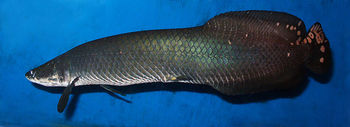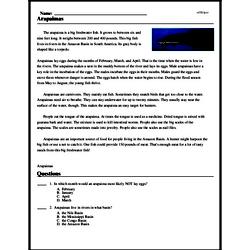Arapaimas
The arapaima is a big freshwater fish. It grows to between six and nine feet long. It weighs between 200 and 400 pounds. This big fish lives in rivers in the Amazon Basin in South America. Its gray body is shaped like a torpedo.
Arapaimas lay eggs during the months of February, March, and April. That is the time when the water is low in the rivers. The arapaima makes a nest in the muddy bottom of the river and lays its eggs. Male arapaimas have a key role in the incubation of the eggs. The males incubate the eggs in their mouths. Males guard the eggs and move them whenever danger is around. The eggs hatch when the water begins to rise. During the flood season from May to August, the young fish thrive.
Arapaimas are carnivores. They mainly eat fish. Sometimes they snatch birds that get too close to the water. Arapaimas need air to breathe. They can stay underwater for up to twenty minutes. They usually stay near the surface of the water, though. This makes the arapaima an easy target for hunters.




